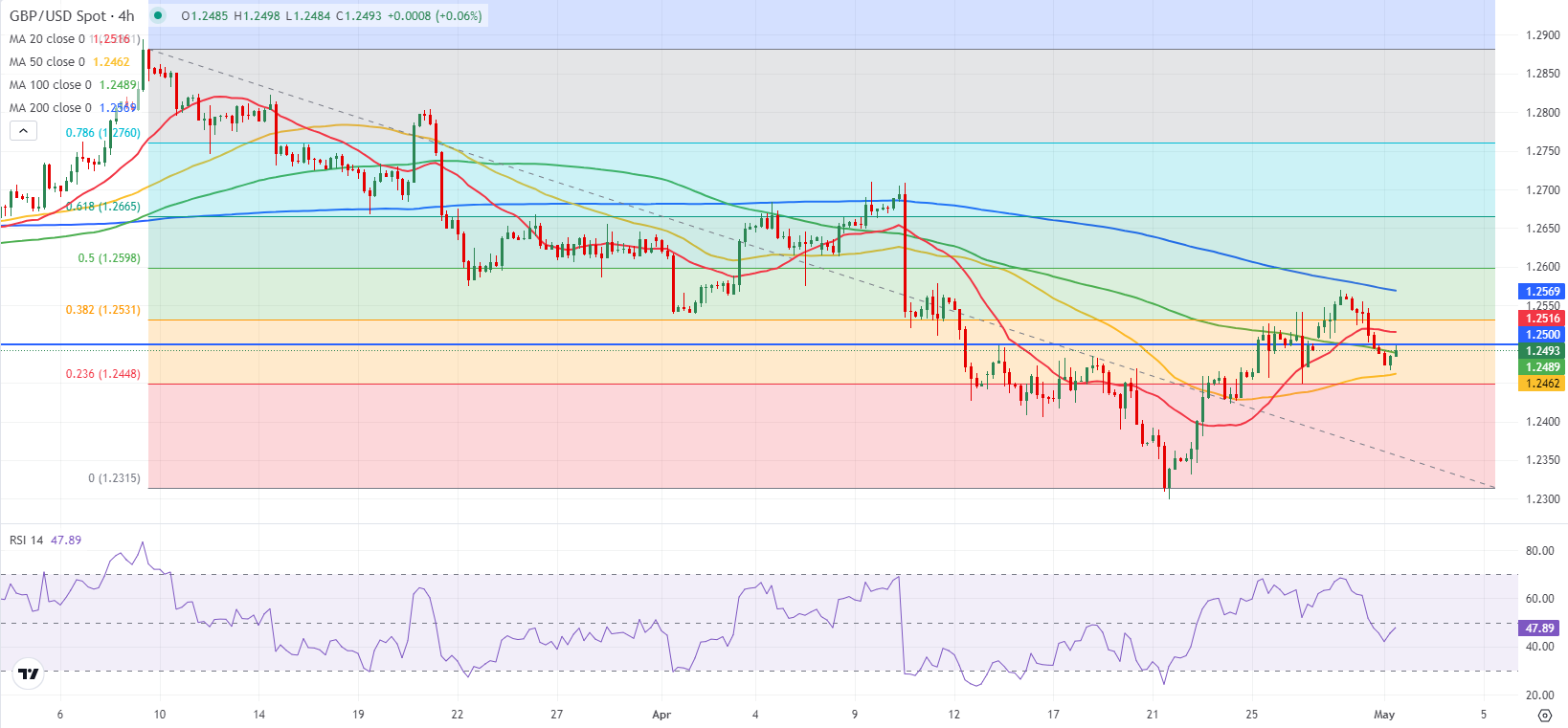- GBP/USD fluctuates in a tight range below 1.2500 on Wednesday.
- Markets remain risk-averse ahead of the Fed policy announcements.
- ADP Employment Change and ISM Manufacturing PMI will be featured in the US economic calendar.
GBP/USD declined sharply on Tuesday and erased all of Monday's gains. The pair fluctuates in a tight range below 1.2500 as trading action remains subdued, with most major European markets staying closed in observance of the Labor Day holiday.
The renewed US Dollar (USD) strength caused GBP/USD to turn south in the American session on Tuesday. The Employment Cost Index rose 1.2% in the first quarter. This reading followed the 0.9% increase recorded in the previous quarter and surpassed the market expectation of 1%, reviving fears over strengthening wage inflation.
Early Wednesday, US stock index futures trade deep in negative territory, supporting the USD and not allowing GBP/USD to gather recovery momentum.
The US economic docket will feature ADP Employment Change and the ISM Manufacturing PMI for April. The market reaction to these data is likely to remain short-lived, with investors refraining from taking large positions ahead of the Federal Reserve's (Fed) monetary policy announcements. Nevertheless, disappointing data could make it difficult for the USD to build on Tuesday's rally.
The Fed is expected to maintain the policy rate at 5.25%-5.5% after April 30 - May 1 policy meeting. Investors will look for changes in the statement language and scrutinize Chairman Jerome Powell's comments for fresh insights into the possible timing of the policy pivot.
Markets are currently pricing a 94% probability that the Fed will leave the policy rate unchanged again in June. The probability of a rate cut in September stays slightly below 50%, according to CME FedWatch Tool. In case Powell adopts a concerning tone regarding the inflation outlook and causes markets to lean toward a rate cut toward the end of the year, the USD could continue to outperform its rivals and weigh on GBP/USD. On the other hand, the pair could stage a decisive rebound if Powell leaves the door open to a rate reduction in September.
GBP/USD Technical Analysis
The Relative Strength Index (RSI) indicator on the 4-hour chart stays slightly below 50, while GBP/USD trades near the 100-period Simple Moving Average (SMA), currently located at around 1.2490.
In case GBP/USD stays below 1.2490-1.2500 resistance area, sellers could remain interested. In this scenario, 1.2450 (Fibonacci 23.6% retracement of the latest downtrend) and 1.2400 (static level, psychological level) could be set as next bearish targets.
On the upside, 1.2530 (Fibonacci 38.2% retracement) aligns as interim resistance ahead of 1.2560 (200-day SMA) and 1.2600 (Fibonacci 50% retracement).
Pound Sterling FAQs
The Pound Sterling (GBP) is the oldest currency in the world (886 AD) and the official currency of the United Kingdom. It is the fourth most traded unit for foreign exchange (FX) in the world, accounting for 12% of all transactions, averaging $630 billion a day, according to 2022 data. Its key trading pairs are GBP/USD, aka ‘Cable’, which accounts for 11% of FX, GBP/JPY, or the ‘Dragon’ as it is known by traders (3%), and EUR/GBP (2%). The Pound Sterling is issued by the Bank of England (BoE).
The single most important factor influencing the value of the Pound Sterling is monetary policy decided by the Bank of England. The BoE bases its decisions on whether it has achieved its primary goal of “price stability” – a steady inflation rate of around 2%. Its primary tool for achieving this is the adjustment of interest rates. When inflation is too high, the BoE will try to rein it in by raising interest rates, making it more expensive for people and businesses to access credit. This is generally positive for GBP, as higher interest rates make the UK a more attractive place for global investors to park their money. When inflation falls too low it is a sign economic growth is slowing. In this scenario, the BoE will consider lowering interest rates to cheapen credit so businesses will borrow more to invest in growth-generating projects.
Data releases gauge the health of the economy and can impact the value of the Pound Sterling. Indicators such as GDP, Manufacturing and Services PMIs, and employment can all influence the direction of the GBP. A strong economy is good for Sterling. Not only does it attract more foreign investment but it may encourage the BoE to put up interest rates, which will directly strengthen GBP. Otherwise, if economic data is weak, the Pound Sterling is likely to fall.
Another significant data release for the Pound Sterling is the Trade Balance. This indicator measures the difference between what a country earns from its exports and what it spends on imports over a given period. If a country produces highly sought-after exports, its currency will benefit purely from the extra demand created from foreign buyers seeking to purchase these goods. Therefore, a positive net Trade Balance strengthens a currency and vice versa for a negative balance.
Information on these pages contains forward-looking statements that involve risks and uncertainties. Markets and instruments profiled on this page are for informational purposes only and should not in any way come across as a recommendation to buy or sell in these assets. You should do your own thorough research before making any investment decisions. FXStreet does not in any way guarantee that this information is free from mistakes, errors, or material misstatements. It also does not guarantee that this information is of a timely nature. Investing in Open Markets involves a great deal of risk, including the loss of all or a portion of your investment, as well as emotional distress. All risks, losses and costs associated with investing, including total loss of principal, are your responsibility. The views and opinions expressed in this article are those of the authors and do not necessarily reflect the official policy or position of FXStreet nor its advertisers. The author will not be held responsible for information that is found at the end of links posted on this page.
If not otherwise explicitly mentioned in the body of the article, at the time of writing, the author has no position in any stock mentioned in this article and no business relationship with any company mentioned. The author has not received compensation for writing this article, other than from FXStreet.
FXStreet and the author do not provide personalized recommendations. The author makes no representations as to the accuracy, completeness, or suitability of this information. FXStreet and the author will not be liable for any errors, omissions or any losses, injuries or damages arising from this information and its display or use. Errors and omissions excepted.
The author and FXStreet are not registered investment advisors and nothing in this article is intended to be investment advice.
Recommended Content
Editors’ Picks

AUD/USD: Bears still dominate the sentiment
AUD/USD quickly reversed Monday’s auspicious start to the week on Tuesday, shifting its attention to the downside and printing new multi-week lows near 0.6430 ahead of the release of inflation data in Oz.

EUR/USD: Sellers will not leave it alone
EUR/USD resumed its widespread leg lower on Tuesday, rapidly setting aside Monday’s bullish price action and returning to the area below the 1.0500 support prior to key US data releases on Wednesday.

Gold under pressure below $2,630
Gold fluctuates above $2,600 on Tuesday after sliding almost three percent – a whopping $90 plus – on Monday due to rumors Israel and Hezbollah were on the verge of agreeing on a ceasefire. Whilst good news for Lebanon, this was not good news for Gold as it improved the outlook for geopolitical risk.

Bitcoin needs a further correction for sustained growth
After weeks of rapid growth, Bitcoin (BTC-USD) entered the maximum turbulence zone falling below $94,000. BTC is currently trading at $93,764 and continues to trend downward, having exited the ascending channel.

Eurozone PMI sounds the alarm about growth once more
The composite PMI dropped from 50 to 48.1, once more stressing growth concerns for the eurozone. Hard data has actually come in better than expected recently – so ahead of the December meeting, the ECB has to figure out whether this is the PMI crying wolf or whether it should take this signal seriously. We think it’s the latter.

Best Forex Brokers with Low Spreads
VERIFIED Low spreads are crucial for reducing trading costs. Explore top Forex brokers offering competitive spreads and high leverage. Compare options for EUR/USD, GBP/USD, USD/JPY, and Gold.
